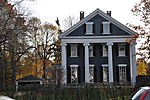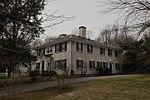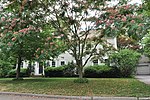Strong's Block
Buildings and structures in Newton, MassachusettsColonial Revival architecture in MassachusettsCommercial blocks on the National Register of Historic Places in MassachusettsCommercial buildings completed in 1896National Register of Historic Places in Newton, Massachusetts ... and 1 more
Newton, Massachusetts Registered Historic Place stubs

Strong's Block is a historic commercial building at 1637–1651 Beacon Street in the center of Waban Village, in the city of Newton, Massachusetts. Built in 1896, this 2+1⁄2-story brick Flemish Revival structure is one of a small number of surviving 19th century commercial blocks in the city. The building was designed by Waban resident Lewis H. Bacon for William Strong, another local resident, who sought to capitalize on the construction of the nearby Circuit Railroad (now the MBTA Green Line D branch).The building was listed on the National Register of Historic Places in 1986.
Excerpt from the Wikipedia article Strong's Block (License: CC BY-SA 3.0, Authors, Images).Strong's Block
Beacon Street, Newton Waban
Geographical coordinates (GPS) Address Nearby Places Show on map
Geographical coordinates (GPS)
| Latitude | Longitude |
|---|---|
| N 42.326555555556 ° | E -71.231055555556 ° |
Address
Beacon Street 1645
02468 Newton, Waban
Massachusetts, United States
Open on Google Maps










